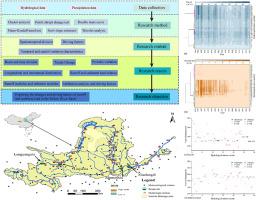1960-2023年黄河干流至入海口径流输沙量时空变化特征
IF 8.4
2区 环境科学与生态学
Q1 ENVIRONMENTAL SCIENCES
引用次数: 0
摘要
从科学治理的角度把握黄河流域径流沙负荷的时空变化特征及其驱动因素,对制定流域径流沙负荷管理策略具有重要意义。基于聚类分析、Pettitt突变检验、Mann-Kendall趋势检验、Sen’s斜率估计、小波分析和双质量曲线(DMC)等方法,对1960 - 2023年长江上游32个干流站和34个主要支流水文站的RS序列进行了分析,确定了关键驱动因素,并量化了其归因率。结果表明:(1)三峡库区划分为5个河段(B1:鸡麦上游、B2:鸡麦-塘耐海、B3:塘耐海-邓口、B4:邓口-龙门、B5:龙门-利金)和3个时期(P1: 1960—1986年、P2: 1987—1999年、P3: 2000—2023年),RS分布差异显著,特别是兰州上游径流量较大,头道岔—潼关输沙较大。(2)全流域RS呈显著下降趋势,尤其是B4-B5流域的径流和B3-B5流域的泥沙负荷,径流模量/泥沙负荷模量分别比P1降低了62.34%/33.42%和67.20%/60.79%。(3)人类活动对径流减少的贡献较大,占径流减少的87.77%,占沙量减少的84.16%,而气候变化对径流减少的贡献较小,分别为12.23%和15.84%。研究成果可为流域水资源的合理利用和生态保护提供科学技术支持。本文章由计算机程序翻译,如有差异,请以英文原文为准。

Spatiotemporal variations in runoff and sediment load of the mainstem and major tributaries of the Yellow River Basin from the headwater to the estuary (1960–2023)
Mastering the spatiotemporal variations and driving factors of runoff and sediment load (RS) in the Yellow River Basin (YRB) from the perspective of scientific governance is essential for formulating management strategies. Based on the clustering analysis, Pettitt abrupt change test, Mann-Kendall trend test, Sen's slope estimator, Wavelet analysis, and Double Mass Curve (DMC), This study analyzed the RS series from 32 mainstem and 34 major tributary hydrological stations across the YRB from 1960 to 2023, identified key driving factors, and quantified their attribution rates. The main findings were as follows: (1) The YRB was categorized into five segments (B1: upstream of Jimai, B2: Jimai-Tangnaihai, B3: Tangnaihai-Dengkou, B4: Dengkou-Longmen, B5: Longmen-Lijin) and three periods (P1: 1960–1986, P2: 1987–1999, P3: 2000–2023), with significant differences in RS distribution, particularly larger runoff in the upstream of Lanzhou and larger sediment load in the Toudaoguai-Tongguan. (2) Significant decreasing trends in RS were observed across the basin, particularly in the runoff of the B4-B5 and sediment load in B3-B5, with reductions in runoff modulus/sediment load modulus by 62.34%/33.42% and 67.20%/60.79% in the P2 and P3 compared to P1, respectively. (3) The contribution of human activities to the reduction of RS was found to be substantial, accounting for 87.77% of the runoff decrease and 84.16% of the sediment load reduction, while climate change accounted for a relatively minor portion (12.23% and 15.84%, respectively). The research results can provide scientific and technological support for the rational utilization of water resources and ecological protection in the basin.
求助全文
通过发布文献求助,成功后即可免费获取论文全文。
去求助
来源期刊

Journal of Environmental Management
环境科学-环境科学
CiteScore
13.70
自引率
5.70%
发文量
2477
审稿时长
84 days
期刊介绍:
The Journal of Environmental Management is a journal for the publication of peer reviewed, original research for all aspects of management and the managed use of the environment, both natural and man-made.Critical review articles are also welcome; submission of these is strongly encouraged.
 求助内容:
求助内容: 应助结果提醒方式:
应助结果提醒方式:


